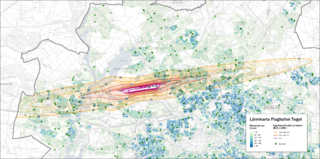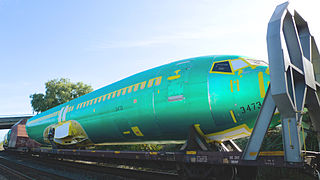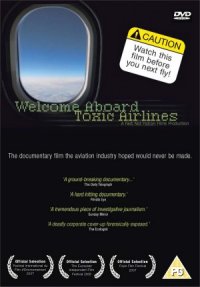
A flight attendant, traditionally known as a steward or stewardess ; or air host or hostess, is a member of the aircrew aboard commercial flights, many business jets and some government aircraft. Collectively called cabin crew, flight attendants are primarily responsible for passenger safety and comfort.

Aircraft noise pollution refers to noise produced by aircraft in flight that has been associated with several negative stress-mediated health effects, from sleep disorders to cardiovascular disorders. Governments have enacted extensive controls that apply to aircraft designers, manufacturers, and operators, resulting in improved procedures and cuts in pollution.

Aviation safety is the study and practice of managing risks in aviation. This includes preventing aviation accidents and incidents through research, educating air travel personnel, passengers and the general public, as well as the design of aircraft and aviation infrastructure. The aviation industry is subject to significant regulation and oversight.
Bleed air in aerospace engineering is compressed air taken from the compressor stage of a gas turbine, upstream of its fuel-burning sections. Automatic air supply and cabin pressure controller (ASCPC) valves bleed air from low or high stage engine compressor sections; low stage air is used during high power setting operation, and high stage air is used during descent and other low power setting operations. Bleed air from that system can be utilized for internal cooling of the engine, cross-starting another engine, engine and airframe anti-icing, cabin pressurization, pneumatic actuators, air-driven motors, pressurizing the hydraulic reservoir, and waste and water storage tanks. Some engine maintenance manuals refer to such systems as "customer bleed air".

Aircrew, also called flight crew, are personnel who operate an aircraft while in flight. The composition of a flight's crew depends on the type of aircraft, plus the flight's duration and purpose.
An uncontrolled decompression is an undesired drop in the pressure of a sealed system, such as a pressurised aircraft cabin or hyperbaric chamber, that typically results from human error, structural failure, or impact, causing the pressurised vessel to vent into its surroundings or fail to pressurize at all.

Air Transat Flight 236 was a transatlantic flight bound for Lisbon, Portugal, from Toronto, Canada, that lost all engine power while flying over the Atlantic Ocean on August 24, 2001. The Airbus A330 ran out of fuel because of a fuel leak caused by improper maintenance. Captain Robert Piché, 48, an experienced glider pilot, and First Officer Dirk DeJager, 28, glided the plane to a successful emergency landing in the Azores, saving all 306 people on board. Most of the passengers on the flight were Canadians visiting Europe or Portuguese expatriates returning to visit family in Portugal. This was also the longest passenger aircraft glide without engines, gliding for nearly 75 miles or 121 kilometres. Following this unusual aviation accident, this aircraft was nicknamed the "Azores Glider".

In aeronautics, an environmental control system (ECS) of an aircraft is an essential component which provides air supply, thermal control and cabin pressurization for the crew and passengers. Additional functions include the cooling of avionics, smoke detection, and fire suppression.

Cabin pressurization is a process in which conditioned air is pumped into the cabin of an aircraft or spacecraft in order to create a safe and comfortable environment for humans flying at high altitudes. For aircraft, this air is usually bled off from the gas turbine engines at the compressor stage, and for spacecraft, it is carried in high-pressure, often cryogenic, tanks. The air is cooled, humidified, and mixed with recirculated air by one or more environmental control systems before it is distributed to the cabin.
Metal fume fever, also known as brass founders' ague, brass shakes, zinc shakes, galvie flu, galvo poisoning, metal dust fever, welding shivers, or Monday morning fever, is an illness primarily caused by exposure to chemicals such as zinc oxide (ZnO), aluminium oxide (Al2O3), or magnesium oxide (MgO) which are produced as byproducts in the fumes that result when certain metals are heated. Other common sources are fuming silver, gold, platinum, and chromium.

Tricresyl phosphate (TCP), is a mixture of three isomeric organophosphate compounds most notably used as a flame retardant. Other uses include as a plasticizer in manufacturing for lacquers and varnishes and vinyl plastics and as an antiwear additive in lubricants. Pure tricresyl phosphate is a colourless, viscous liquid, although commercial samples are typically yellow. It is virtually insoluble in water, but easily soluble in organic solvents like toluene, hexane, and diethylether among others. It was synthesized by Alexander Williamson in 1854 upon reacting phosphorus pentachloride with cresol, though today's manufacturers can prepare TCP by mixing cresol with phosphorus oxychloride or phosphoric acid as well. TCP, especially the all-ortho isomer, is the causative agent in a number of acute poisonings. Its chronic toxicity is also of concern. The ortho-isomer is rarely used on its own outside of laboratory studies that require isomeric purity, due to its extremely toxic nature, and is generally excluded from commercial products where TCP is involved.

A turbine engine failure occurs when a turbine engine unexpectedly stops producing power due to a malfunction other than fuel exhaustion. It often applies for aircraft, but other turbine engines can fail, like ground-based turbines used in power plants or combined diesel and gas vessels and vehicles.

Welcome Aboard Toxic Airlines is a 2007 British documentary film about aerotoxic syndrome directed and produced by former airline captain Tristan Loraine.

On 4 October 1992, El Al Flight 1862, a Boeing 747 cargo aircraft of the Israeli airline El Al, crashed into the Groeneveen and Klein-Kruitberg flats in the Bijlmermeer neighbourhood of Amsterdam, the Netherlands. The crash is known in Dutch as the Bijlmerramp.
The Aerotoxic Association was founded on 18 June 2007, at the British Houses of Parliament by former BAe 146 Training Captain John Hoyte, to raise public awareness about the ill health allegedly caused after exposure to airliner cabin air that he claimed been contaminated to toxic levels, by engine oil leaking into the bleed air system, which pressurizes all jet aircraft, with the exception of the Boeing 787.

On May 5, 1983, a Lockheed L-1011 TriStar, registration N334EA, operating as Eastern Air Lines Flight 855 en route from Miami International Airport to Nassau International Airport, experienced the loss of all three engines near Miami, Florida. The flight crew succeeded in restarting one engine in time to safely land the aircraft at Miami International Airport.

A fume event occurs when bleed air used for cabin pressurisation and air conditioning in a pressurised aircraft is contaminated by fluids such as engine oil, hydraulic fluid, anti-icing fluid, and other potentially hazardous chemicals.

A Dark Reflection is a 2015 British independent investigative thriller film directed and produced by former British Airways airline captain Tristan Loraine. Billed as Erin Brockovich meets All the President's Men and as a fact-based investigative thriller, the film is based on the director's own experience as a commercial pilot.

Uni Air Flight 873 was a Taiwanese domestic passenger flight between Taipei and Hualien that suffered a fire following an explosion after landing at Hualien Airport, Taiwan, on 24 August 1999, resulting in 27 injuries and one death.
Susan Michaelis is a former Australian flight instructor and airline transport pilot. She is also a researcher working on the issue of contaminated air on aircraft and the health effects of exposure to heated jet engine oils and hydraulic fluids known to contaminate the breathing air supply on aircraft, often called aerotoxic syndrome. She is a part of the University of Stirling's Occupational and Environmental Health Research group, where she is an Honorary Sensor Research Fellow.














